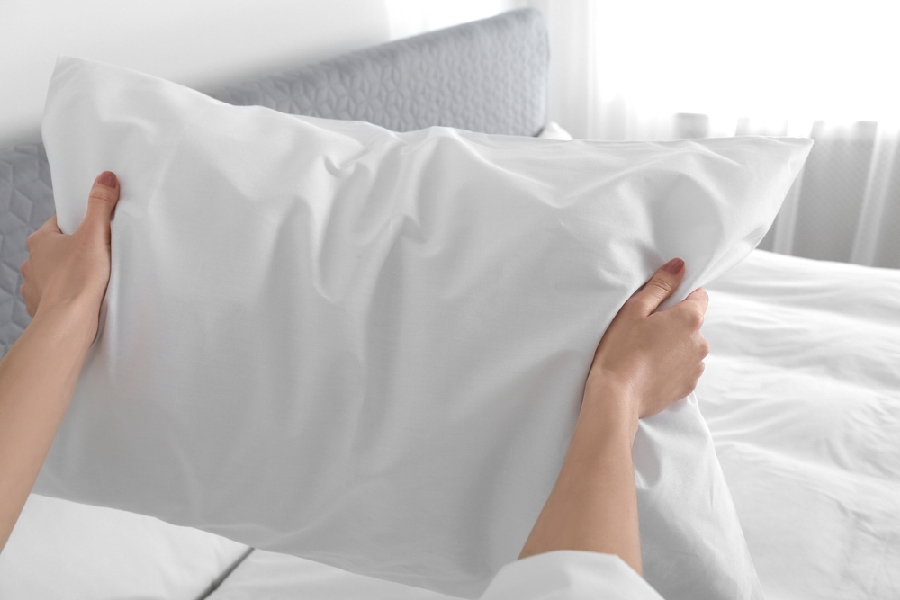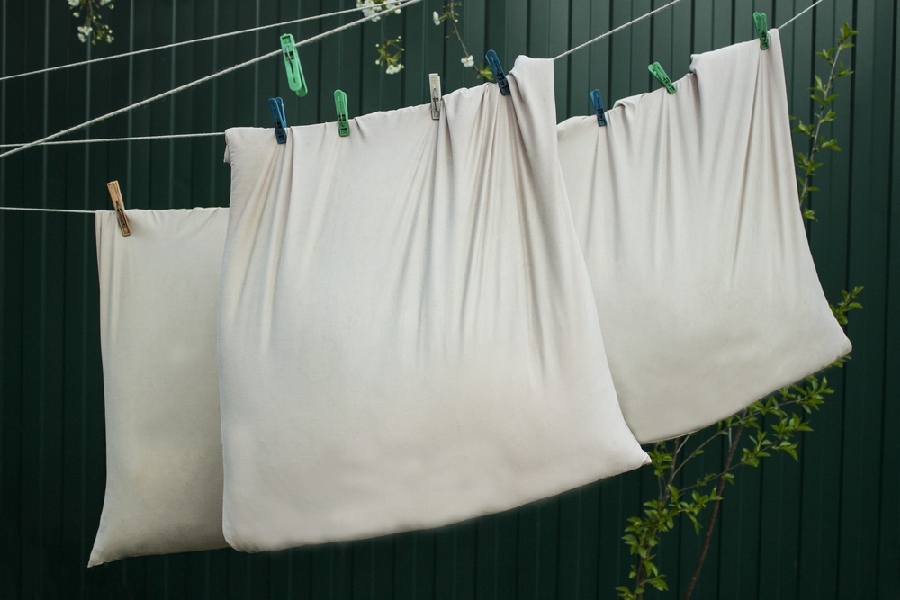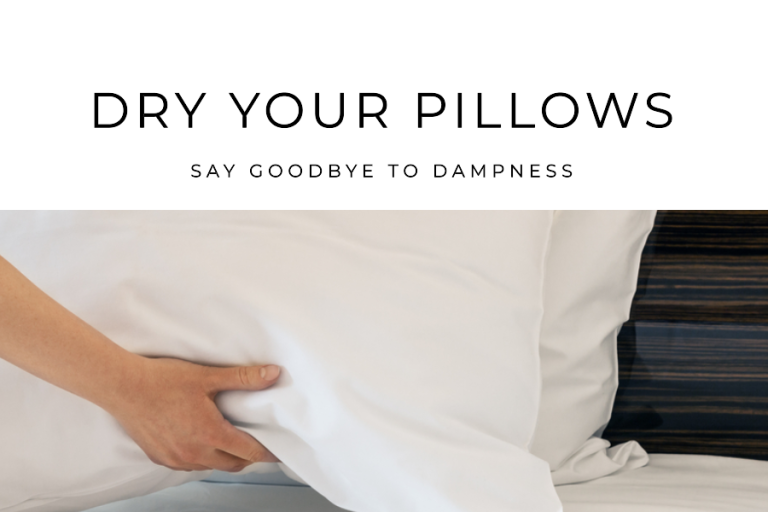To have a good night’s sleep, in addition to owning a soft and comfortable mattress, you also need a fluffy and stretchy pillow. Yet, feather pillows often tend to flatten after a period of use. Flat pillows not only make it difficult to sleep but can also cause some health problems. So, how to fluff a pillow? There are three steps that you might consider taking:
- Inflate the pillow by hand.
- Fluff the pillow using a dryer.
- Place pillows outdoors with fresh air.
To learn more about each step in detail, continue reading this article with us!
Why Should You Fluff Pillows Frequently?

You should fluff your headrest frequently
Sleeping on a comfy pillow is not only a matter of preference; it also affects your physical and mental health.
The height and firmness of a new pillow will determine the quality of your sleep. The most important thing is that your spine needs to rest balanced, neutral, and relaxed. Wrong sleeping positions quickly add extra pressure on the spine and thus cause severe back and neck pain.
After a period of use, the cushion inside the pillow will gradually flatten and peel off. This flat pillow will affect the spine and neck alignment and cause chronic pain. So it would help if you made your pillows fluffy regularly to have a more comfortable sleep.
Using a headrest with the right height, firmness, and overall loft for you will help you wake up more refreshed in the morning.
How To Fluff A Pillow: Step-By-Step Guides
To fluff your pillow, you will need three methods as follows. Explore and choose the most convenient and time-saving method for you.
Fluffing By Hand

Using your hands
Before experimenting with any complicated method, consider using your hands. Follow the steps below to re-stress your down pillows.
- Grab the bottom corner of the pillow with each hand and push them in turn from the inside out. Imagine you are playing a piano accordion or a squeezebox at a much faster pace. Then, reshape the products by hand, so they have a bouncy and inviting look on your nightstand. You can do this hand fluffing in 30 seconds on each face.
- With pillows that aren’t too damp, try punching them to stretch the bowels inside. Punch the sides of your head guard with your hands until it inflates. These feather pillows are the easiest to re-fluff because the material is light and soft. You can also bang them against the bed a few times to make the surface even.
- The final way to properly fluff most pillows is to squeeze them. Hold the head guard vertically and lower and then move your hand down to the center of the surface (slightly up). Quickly press and then release. Repeat this action about five times. Once done, shake the product vigorously again, then smooth the surface for a few seconds before placing it back on the bed.
Fluffing In A Dryer

The dryer
Re-fluffing your pillow using a dryer is our second method. Before performing this action, read labels on products carefully to ensure they are machine washable. Most feather pillows do not tolerate high heat drying because it will dry out the intestines. So, adjust the temperature carefully.
You will need additional equipment for this process, including clean tennis balls or a pair of clean flip-flops.
After placing the pillow in the dryer on low heat or the air setting, add a tennis ball inside a tube sock inside. The robust oscillations of the tennis ball can inflate the bowels quickly. You just need to wait for a few minutes, and your pillow will become full and soft.
For those with babies at home, you might consider adding stuffed animals inside the dryer. It will help to inflate both at the same time and save you more time. Do this action about once a month.
For cotton products, dry them on low heat for about 20 minutes. This action is equivalent to hitting your pillow repeatedly. Make sure that the head support unit is completely dry when taking it out.
You can massage the surfaces later to make them more fluffy.
Leaving Pillows In The Sun

Hanging headrests on the line
Sometimes, nature will give you the most suitable solution. Drying the product in the sun can also dry the head support entirely after washing.
All you need to do is dry the pillow on the clothesline in a sunny spot for a few hours to ensure the air circulation can pass through the intestines.
In the long run, it will absorb all the moisture in the intestines and make them more porous to create fluffiness.
You need to expose the pillowcase for three to four hours to increase fluffiness. This action is also beneficial when you have just purchased a compressed pillow and need to release the “off-gassing” smell during product expansion.
Frequently Asked Questions
To learn more about interesting facts related to fluffing your pillow, continue reading below.
What Are The Extra Tips To Fluff A Pillow?
Check out some of the following tips to make inflating your headrests much more convenient and gentle.
- Double-check your head support care instructions carefully before placing them in the dryer.
- The dryer should not be set to too hot as it may burn or damage the gasket and the product’s guts. Surely no one wants to reuse a product with a burnt smell, right?
- If your headrest is compressed or rolled up in packaging with foam pads, place them in a well-ventilated area to remove odors. It will also allow the product to swell a bit before use.
Should You Wash Pillows?
Yes, you need to clean and clean the pillows every four to six months. However, if your washing is not done correctly, it will affect the intestines of the product.
You just need to use warm water, mild detergent, and fabric softener to clean them. Set the Sanitize mode on your washing machine and choose the fastest spin cycle possible. It will help keep the product from getting wet for too long.
Leaving the pillow unsanitary for a long time will cause it to form a thick layer of dust mites and allergens that adversely affect health.
Each type of headrest includes its way of care. It’s best to check the product’s label before washing it. Yet, we summarize for you a few key points as follows:
- It would be best to machine wash feather pillows on the gentle cycle. Use heatless drying or air drying.
- Down alternative headrests will machine wash in warm water and tumble dry in a tumble dryer at low temperature.
- Memory foam headrests can be cleaned in situ with a damp cloth with mild detergent. Then you can dry them outside.
To learn more about cleaning the product, check out the following video.
When Should You Replace Your Headrests?
Whether or not the current headrest is the right pillow for you, you can’t use it forever. There will be times when the fluff pillows tips we mentioned just don’t work anymore. And now you need to understand the signals to make the right decisions.
Usually, you need to replace products every 1 to 2 years to keep their quality intact. Renewing your headrests regularly can also help prevent bacteria or dirt from accumulating on the product’s surface for a long time.
The sign is obvious and has apparent indentations and swelling. A simple test is to gently squeeze the ends of the product to see if they will swell again. If the dent can’t be repaired, it is time to change your pillowcases.
The great news is that regularly fluffing a pillow can help increase the product’s durability. The average lifespan of these headrests falls between 4 and 6 years. Please pay attention to this issue.

You should replace headrests frequently
What Pillow Types Should You Fluff?
It would be best to stretch the headrests with fibrous fills to keep their shape intact. Common pillow materials include cotton, down, down, down alternative, or wool. You need to fluff your pillows regularly to keep them at the correct height and not become too flat.
On the other hand, headrests with mainly memory foam can hold their shape for a long time without any external impact.
Why Do My Headrests Turn Yellow?
The head support unit tends to turn yellow from perspiration.
In addition, sleeping with wet hair, oil on your skin lacking moisture, or lotion are common causes of surface yellowing. When moisture is left on the surface for a long time, it will yellow the product over time.
It will significantly affect the aesthetics of your bedroom.
The best way to get pillows white again is to use 1/4 cup bleach or Borax. Do not use boiling water as it can damage the fabric. Put the product in soapy water and gently knead with your hands to allow the detergent to penetrate the material.
You can also use other types of bleach, such as baking soda, white vinegar, or liquid dish soap, depending on the severity of the stain.
These cleaners can also remove blood stains from fabric surfaces. Just rinse them in cold water and rub them hard a few times; your pillow will shine again.
Final Thoughts
Old pillows tend to flatten and harden after a long time of use. So, you need to find a way to inflate them to achieve a good and healthy sleep every night.
Hopefully, after reading this article, you know how to fluff a pillow properly. With proper care and maintenance, we believe you can use this head support for a long time without affecting the quality of your sleep.
Thanks for reading our article. Do not forget to share them if you find this article interesting and valuable. To learn more great tips regarding mattresses and bedding, read related articles.



